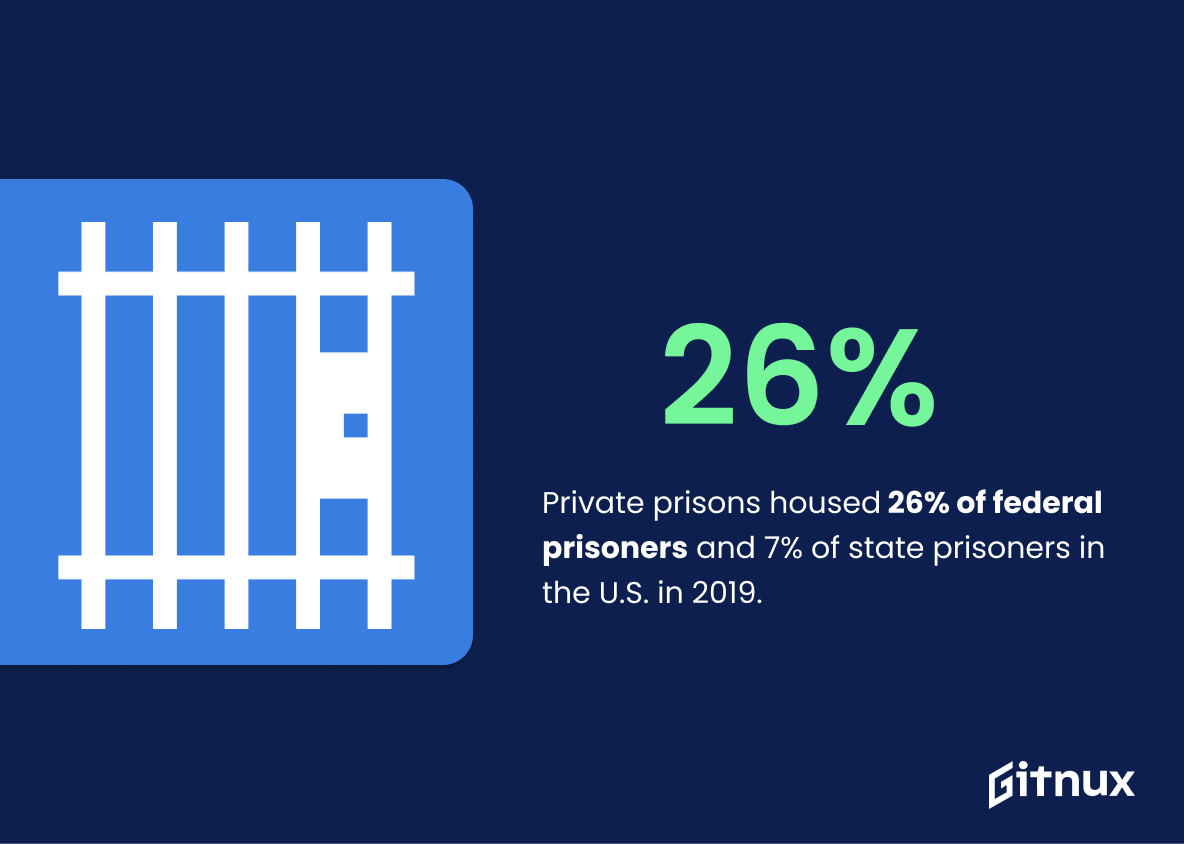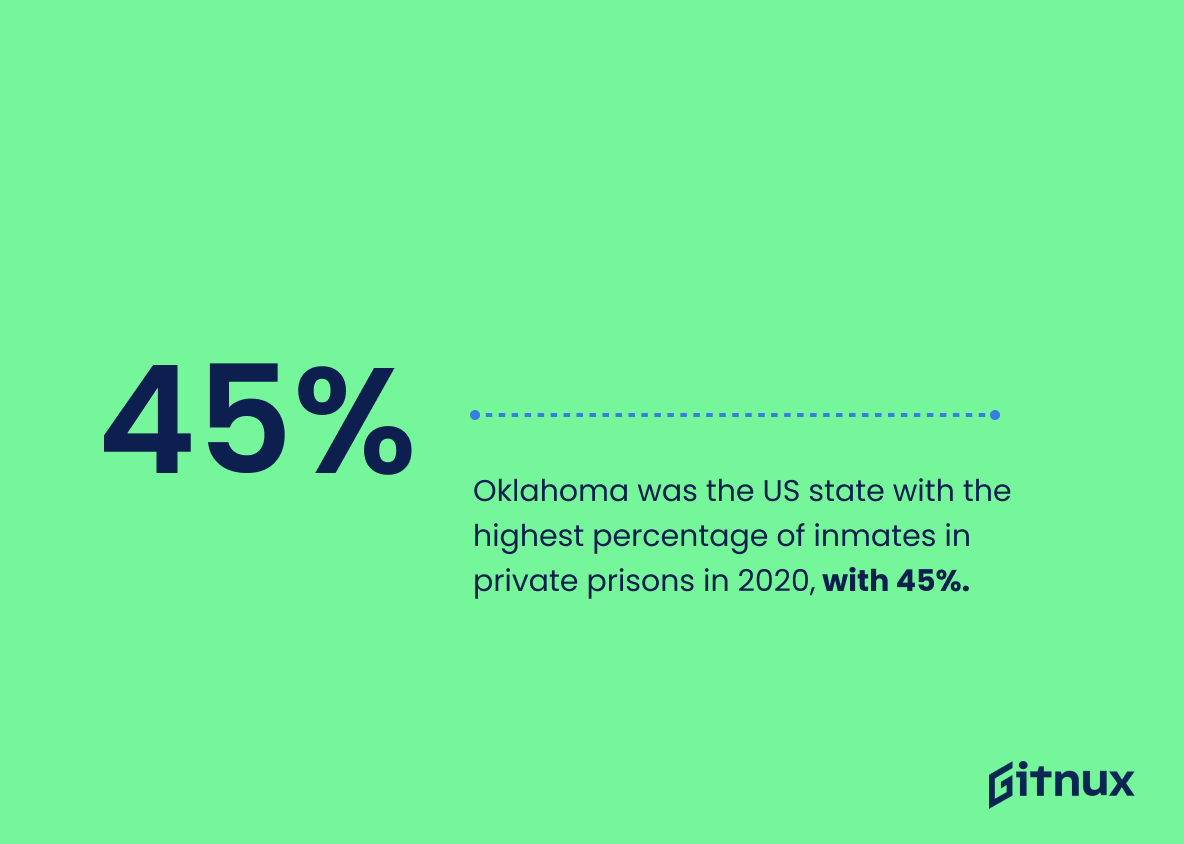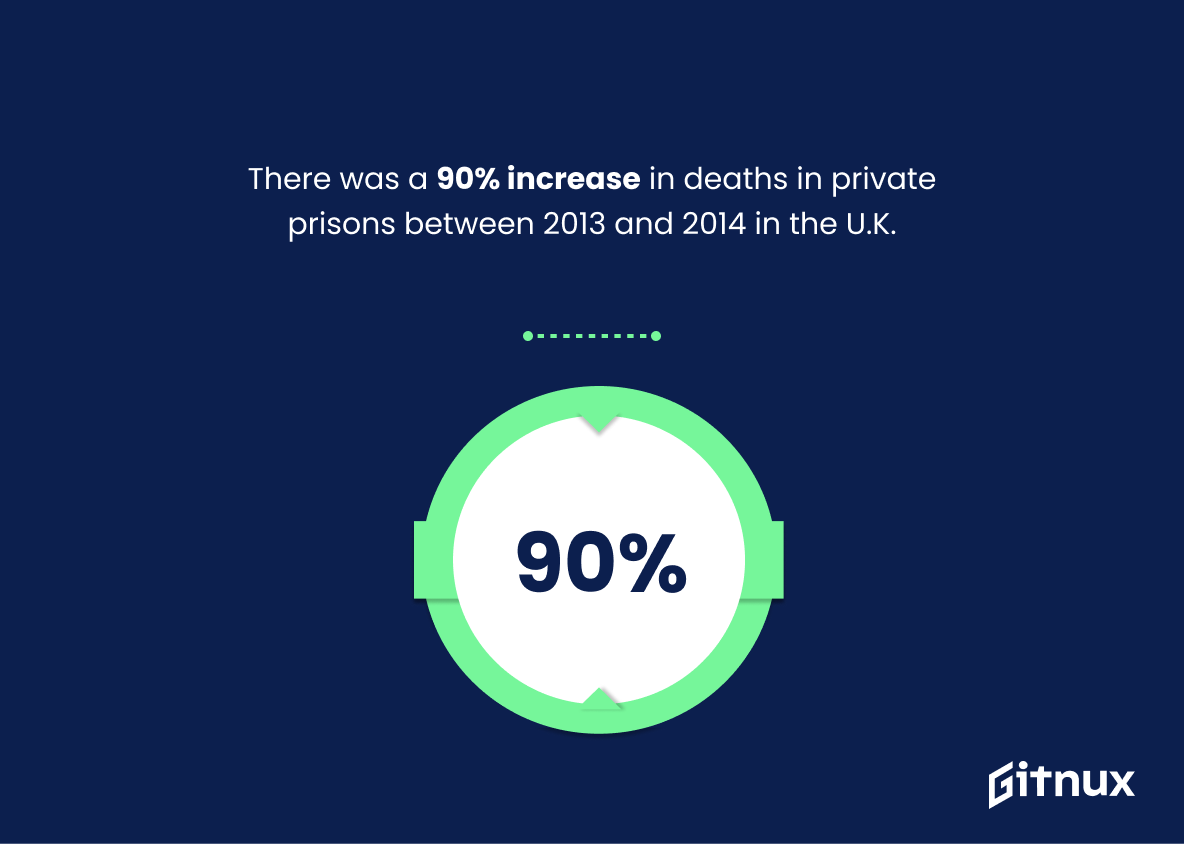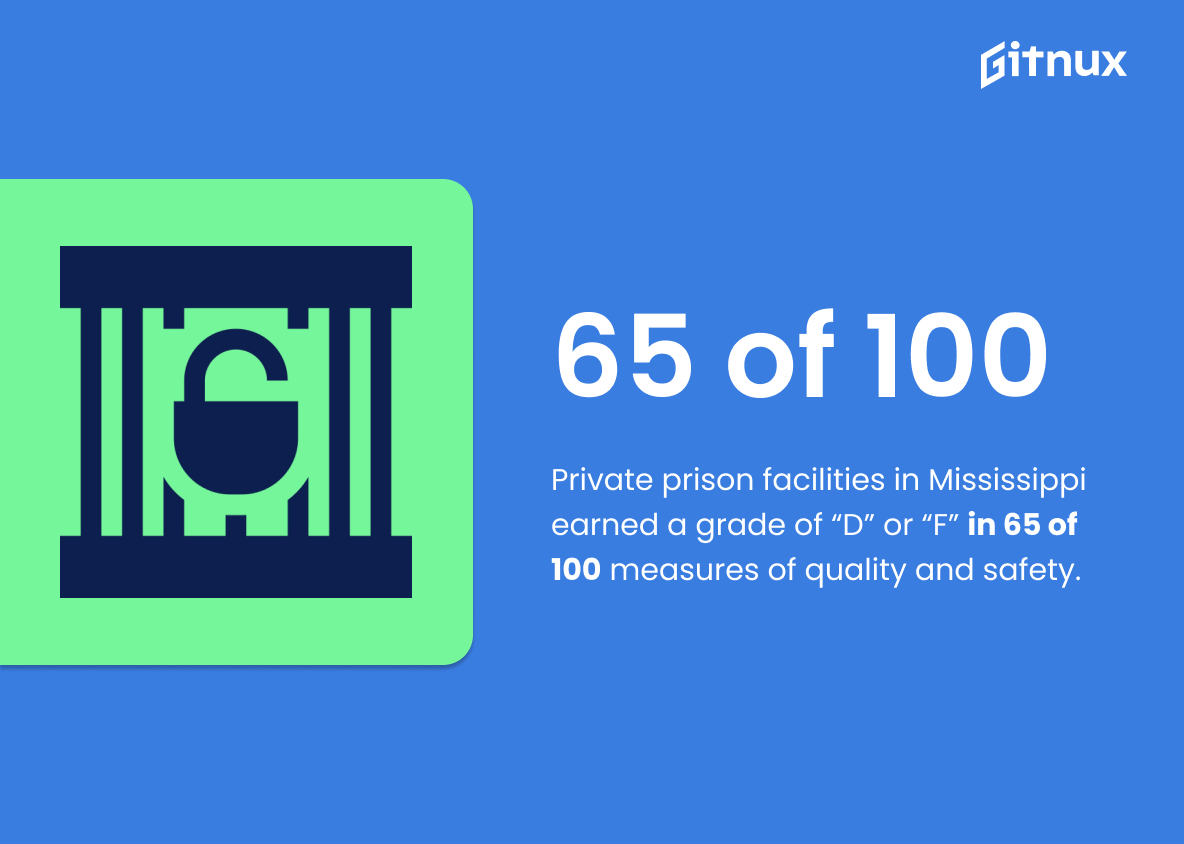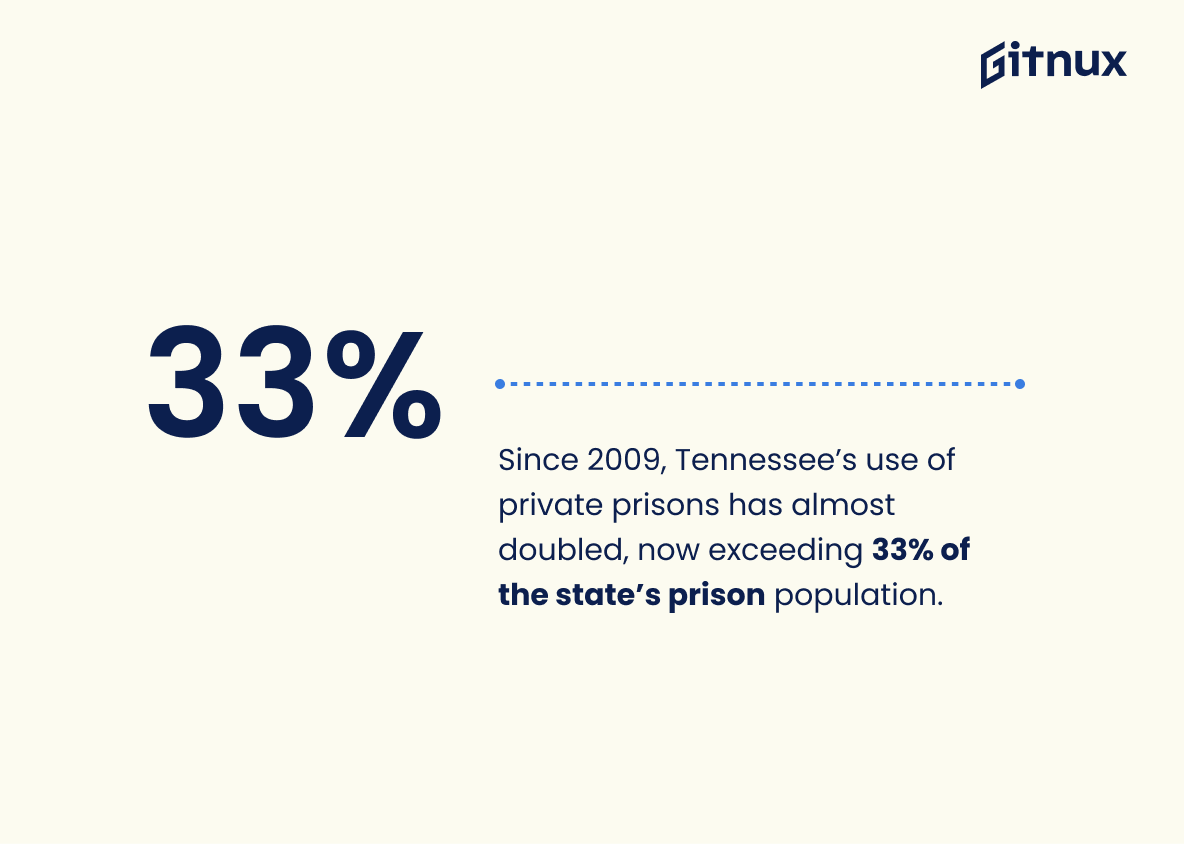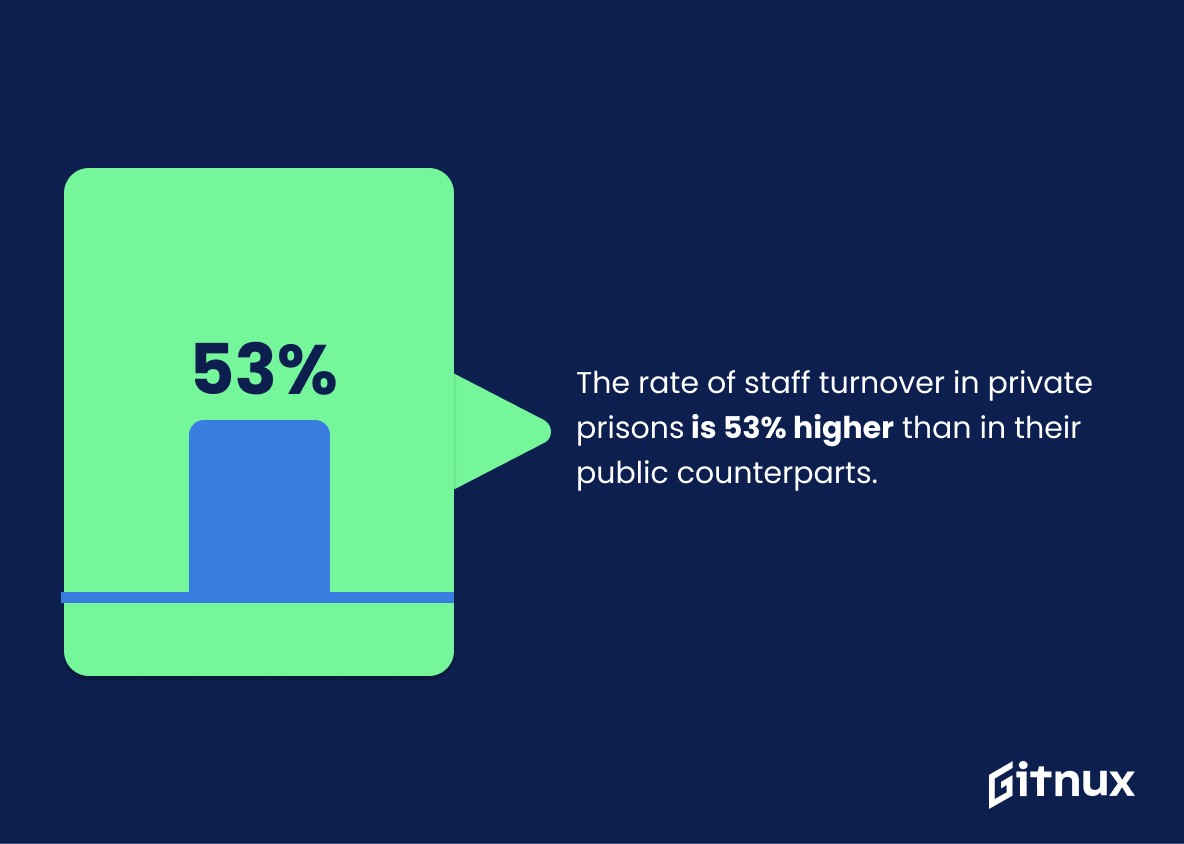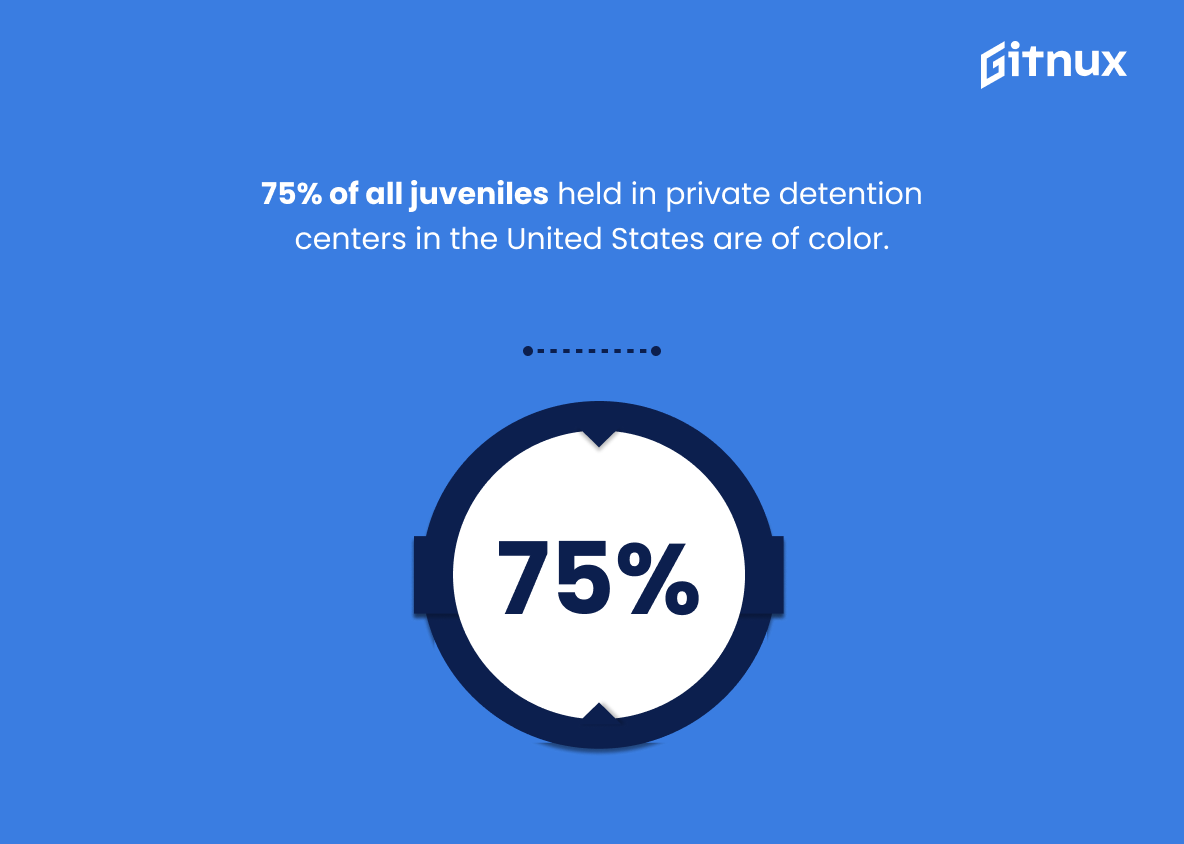The landscape of criminal justice and its mechanism of incarceration is complex, intertwined with numerous elements that are often the subject of intense debates. Among these elements, private prisons have emerged as a controversial cornerstone.
In this blog post, we dig deep into the world of private prison statistics – revealing the scale, nuances, and implications of this burgeoning industry. Whether you’re a policy advocate, a curious citizen, or a scholar, let’s venture together into understanding the facts and figures that continue to shape the pivotal discourse around private prisons.
The Latest Private Prison Statistics Unveiled
Private prisons housed 26% of federal prisoners and 7% of state prisoners in the U.S. in 2019.
Delving into the realm of incarceration, one cannot overlook the striking fact that in 2019, a substantial 26% of federal prisoners and a smaller yet significant 7% of state prisoners in the U.S. found themselves in private prisons. This information illuminates a pivotal point of discussion about the increasing privatization of the American penal system.
The data underscores the expanding role and influence of private corporations in law enforcement – a sector traditionally managed by the state. It emerges as a stark representation that weaves a narrative about the areas where private entities are stepping in to provide prison services. This shift from government-run to privately-managed correctional facilities opens up a multitude of debates about efficiency, human rights, and equitable treatment of prisoners.
In essence, this statistic serves as a gateway to deeper, multifaceted questions about the ethical, economic, and political implications of the growth of private prisons in the United States, perfectly aligning with the thematic focus of a blog post on Private Prison Statistics.
As of 2020, the private prison industry was worth $7.4 billion.
Highlighting the fact that the private prison industry was valued at a staggering $7.4 billion by 2020 underscores the financial magnitude and economic implications of private incarceration. This hefty valuation isn’t just a number; it serves as a powerful indicator of numerous factors. For starters, it reflects the commodification and industrialization of the prison system.
It also sends signals about the thriving market for privatized punishment, suggesting a correlation between incarceration rates and profitability. Furthermore, this figure triggers a critical discussion on how this industry’s income may influence policy and legal measures, shaping the future of criminal justice institutionally and placing a dollar figure on freedom.
Oklahoma was the US state with the highest percentage of inmates in private prisons in 2020, with 45%.
With the spotlight on Oklahoma as the reigning US state dispatching the lion’s share of inmates, a staggering 45%, to the confines of private prisons in 2020, we delve deep into the implications. Unearthing these numbers throws a stark light on the growing dependency on the privatized prison system in Oklahoma, which sees these institutions not merely as correctional facilities, but profitable ventures.
This figure, accentuated through the vibrant tapestry of Private Prison Statistics, helps contextualize the conversation on prison profitability versus rehabilitation efficacy, triggering important dialogues on the ethical ramifications of such trends. This raised awareness invites readers to question state justice policies and further explore potential disparities or issues linked with privatized prison systems.
73.8% of immigrants detained in the United States were held in private detention facilities as of March 2020.
Unveiling the truth behind private prisons, an eye-opening reality emerges – the fact that, as of March 2020, the cages of U.S. private detention facilities held a staggering 73.8% of detained immigrants. This percentage is of significant note in a discursive analysis of private prison statistics. This single figure breathes life into the scale and depth of privatization within the American detention system.
The prominence of private companies in them, with an uncomfortably high percentage of immigrants at their helm, raises questions about the operational practices, ethical standards and quality of conditions within these centers. Far from being a mere number, it paints a striking picture of how intertwined the outsourcing of incarcerations is with the complexities of immigration in modern-day America. It quakes the grounds of justice, private profit agendas, and human rights issues, demanding a harder look into the rising influence of private citizenship behind bars.
There was a 90% increase in deaths in private prisons between 2013 and 2014 in the U.K.
In the realm of Private Prison Statistics, that 90% increase in inmate mortalities in the UK between 2013 and 2014 acts as an alarming touchstone, a stark ink marker illustrating potential systemic issues. This precipitous escalation isn’t just a cold, detached figure; rather, it’s an urgent tapestry interwoven with life and death, safety and danger, efficiency and disparity in private prison facilities. It stands as a loud gavel rap in the courtroom of corrections debate, coloring the discourse about private prisons’ effectiveness and humaneness.
The information nudges readers to question and investigate if there are flaws in the private prison model contributing to this rise, whether these may lay in security, healthcare provision, or overall management. This statistic, in essence, spurs the discussion and inquiry needed to invoke change and improvement.
Private prison facilities in Mississippi earned a grade of “D” or “F” in 65 of 100 measures of quality and safety.
The revelation of private prison facilities in Mississippi raking in a dreary “D” or even worse “F” in 65 out of 100 measures of quality and safety forms a potent piece of knowledge in any discourse focused on Private Prison Statistics. This data offers an eye-opening insight into the grim realities lurking behind the prison walls within this jurisdiction.
Especially on a blog, such statistics carry a heavy weight, shedding light on the less-than-satisfactory conditions, safety issues, and substandard protocols that mark the operations of private prisons in the area. They underscore the urgent need for improvements and reforms, sparking debates and dialogues around policy change and administrative overhaul.
Moreover, these figures can strike a hard blow to the reader’s perception of the efficiency and accountability of privately-run prison institutions, raising valid questions about their ability to maintain optimal standards and ensure inmate wellbeing. Thus, they not only construct a harsh critique of the Mississippi private prisons but also serve as a call to action for all stakeholders in the corrections landscape.
The use of private prisons has prisoner escape rates that are approximately three times higher than their public counterparts.
Drawing attention towards this menacing discrepancy in escape rates between private and public prisons, indeed serves as a spotlight on the critical disparities within our incarceration system. It creates a compelling case for scrutiny and further exploration. It forms a pivotal point in our discussion around private prison statistics, adding depth to the conversation with hard-hitting facts.
It sends out a strong message on the potential implications of prioritizing cost-efficiency over the cardinal tenets of incarceration – safety, security, and reform. Essentially, it paints a stark portrait, one that questions the efficacy, management, and the overall framework of private prisons, instigating judicious dialogue around the need for reforms in private prisons.
Since 2009, Tennessee’s use of private prisons has almost doubled, now exceeding 33% of the state’s prison population.
The rise of private prisons in Tennessee, as evidenced by the doubling of its use since 2009 to now exceed 33% of the state’s total prison population, forms a pivotal point in the canvas of national prison demographics. This shift not only punctuates a growing trend towards privatisation of incarceration services, but also unveils underlying implications on policy making, social justice, and economic factors.
This dramatic increase illustrates vividly the lived reality of privatisation, helping readers grasp the magnitude and pace of change in Tennessee, thereby adding depth to the broader discussion on Private Prison Statistics in a blog post.
The rate of staff turnover in private prisons is 53% higher than in their public counterparts.
Delving into the mesmerizing world of private prison statistics, an intriguing fact surfaces like a beacon, highlighting the stark contrast between public and private ventures. The staff turnover rate in private institutions surpasses that of public ones by an impressive 53%. This isn’t just an idiosyncratic quirk of the system, rather it wraps up a compelling narrative about the distinct operational environments in these variations of correctional facilities.
Scrutinizing this staggering discrepancy gives us valuable insights into the challenges faced by private prisons. It can reflect issues such as job dissatisfaction, poor work conditions, or inadequate compensation, underlying a systemic problem that demands attention – making this not only a number, but a powerful advocate for reform within the industry.
High turnover could hint towards persistent instability which can disrupt order within the institution, risk compromising security, and potentially degrade the quality of inmate management and rehabilitative services. Moreover, frequent changes of guards may impede the development of effective relationships between staff and offenders, a cornerstone in ensuring successful reintegration into society.
In essence, this statistic stands out as an unspoken chronicle, urgently narrating the nuanced complexities of private prison operations. It adds a bold stroke of emphasis to our ongoing discourse on private prison statistics, magnifying the need for deeper discussions, strategic actions, and reforms in our pursuit of a more balanced and effective correctional system.
75% of all juveniles held in private detention centers in the United States are of color.
Shining a spotlight on the statistic that ‘75% of all juveniles held in private detention centers in the United States are of color’ illuminates the deeply embedded racial disparities that persist in the private prison system. It sends a shockwave through our understanding of the justice system, prompting a second look at the dynamic interplay between race and incarceration.
This data point not only underscores the challenges faced by minorities in the system, but also serves as a wake-up call to audiences who are not aware of or choose to ignore the racial imbalance in private detention centers. Ultimately, it throws into stark relief the urgent need for reform in the private prison industry’s operational processes, thereby providing a foundation for much-needed discourse and action.
New Mexico had the largest share of inmates in private prisons at nearly 50% in 2019.
Highlighting the stark reality of New Mexico’s high percentage of inmates in private prisons is integral to our discussion on Private Prison Statistics. New Mexico, with approximately half of its inmate population housed in private facilities in 2019, serves as a prime and stark example of the growing influence and business of the private prison industry.
This substantial figure not only demonstrates the state’s heavy reliance on these institutions, but also underlines an essential question about private vs. public jurisdiction of prison systems, their costs, and ethical ramifications, that we aim to unravel in this blog. The New Mexico example paints a clear picture, allowing readers to better appreciate the magnitude and implications of the broader narrative on private prisons.
Conclusion
The data on private prison statistics underscore the complexities surrounding the privatization of incarceration. As we have seen, while private prisons might appear financially beneficial in the short term, they don’t necessarily guarantee improvements in recidivism rates, inmate safety, or constitutional rights.
Detaining individuals should never be motivated or influenced by profit. It’s crucial to continue the dialogue on this critical topic, reassess our current system, and strive for a more balanced, human-centered approach that prioritizes rehabilitation and public safety. After all, the ultimate aim of any prison system should always be justice, fairness, and a safer society for everyone.
References
0. – https://www.freedomforimmigrants.org
1. – https://www.www.aclu.org
2. – https://www.www.statista.com
3. – https://www.www.ibisworld.com
4. – https://www.www.tennessean.com
5. – https://www.www.prisonpolicy.org
6. – https://www.www.justicepolicy.org
7. – https://www.www.theguardian.com
8. – https://www.www.cbsnews.com
9. – https://www.www.stateintegrity.org
